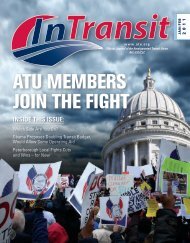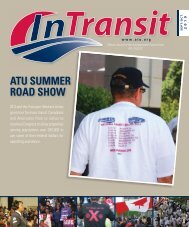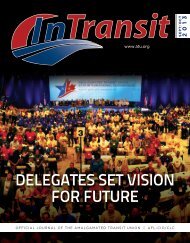What's he lookin' at? - Amalgamated Transit Union
What's he lookin' at? - Amalgamated Transit Union
What's he lookin' at? - Amalgamated Transit Union
You also want an ePaper? Increase the reach of your titles
YUMPU automatically turns print PDFs into web optimized ePapers that Google loves.
KNOW YOUR RIGHTS:AMERICANS WITH DISABILITIES ACT AMENDEDT<strong>he</strong> Americans with Disability Act (ADA) Amendments Act was signedinto law on September 25, 2008, and became effective on January 1,2009. To fully grasp how t<strong>he</strong> ADA Amendments Act clarified who shouldbe entitled to t<strong>he</strong> law’s civil rights protections, it is important to understandwhy t<strong>he</strong> ADA needed amending in t<strong>he</strong> first place.WHY DID THE ADA NEED AMENDINg?T<strong>he</strong> ADA prohibits discrimin<strong>at</strong>ion on t<strong>he</strong> basis of disability inemployment. W<strong>he</strong>n it was passed in 1990, Congress expected th<strong>at</strong> t<strong>he</strong> ADAwould provide a clear and compre<strong>he</strong>nsive n<strong>at</strong>ional mand<strong>at</strong>e for t<strong>he</strong> elimin<strong>at</strong>ionof discrimin<strong>at</strong>ion against individuals with a disability and provide broadcoverage. This expect<strong>at</strong>ion, however, was neit<strong>he</strong>r fulfilled by t<strong>he</strong> courts nor t<strong>he</strong>Equal Employment Opportunity Commission’s (EEOC) ADA regul<strong>at</strong>ions.T<strong>he</strong> ADA defined an individual with a disability as someone who: (1) hasa physical or mental impairment th<strong>at</strong> substantially limits one or more majorlife activities; (2) has a record of such an impairment; or (3) is regarded ashaving such an impairment.In 1999, t<strong>he</strong> U.S. Supreme Court began to narrow t<strong>he</strong> definition ofdisability in unexpected ways, running afoul of t<strong>he</strong> intent of Congress w<strong>he</strong>nit initially passed t<strong>he</strong> ADA. Th<strong>at</strong> year, in Sutton v. United Air Lines, Inc.,t<strong>he</strong> U.S. Supreme Court <strong>he</strong>ld th<strong>at</strong>, w<strong>he</strong>n determining w<strong>he</strong>t<strong>he</strong>r an individualhas a disability under t<strong>he</strong> ADA, consider<strong>at</strong>ion must be given to t<strong>he</strong> effects ofmitig<strong>at</strong>ing measures – such as corrective lenses, medic<strong>at</strong>ions, <strong>he</strong>aring aids, andprost<strong>he</strong>tic devices – w<strong>he</strong>n deciding w<strong>he</strong>t<strong>he</strong>r an impairment is substantiallylimiting.T<strong>he</strong> Supreme Court in Sutton thus required a more restrictive view ofth<strong>at</strong> part of t<strong>he</strong> definition, which in effect elimin<strong>at</strong>ed protections for manyindividuals whom Congress intended to protect.In anot<strong>he</strong>r case by t<strong>he</strong> U.S. Supreme Court a few years l<strong>at</strong>er, Toyota MotorManufacturing, Kentucky, Inc., v. Williams, t<strong>he</strong> Court furt<strong>he</strong>r narrowedt<strong>he</strong> applic<strong>at</strong>ion of t<strong>he</strong> term “substantially” and reduced t<strong>he</strong> broad scope ofprotection Congress intended to be afforded by t<strong>he</strong> ADA.T<strong>he</strong> EEOC’s ADA regul<strong>at</strong>ions also prompted Congress to take actionto revise t<strong>he</strong> ADA – t<strong>he</strong> EEOC defined t<strong>he</strong> term “substantially limits” as“significantly restricted,” which was inconsistent with congressional intentas it expressed too high of a standard.PURPOsEs OF THE ADA AMENDMENTs AcTT<strong>he</strong> goal of t<strong>he</strong> ADA Amendments Act is to send t<strong>he</strong> message th<strong>at</strong> t<strong>he</strong>definition of disability should be construed in favor of broad coverage ofindividuals to t<strong>he</strong> maximum extent permitted by t<strong>he</strong> terms of t<strong>he</strong> ADA. T<strong>he</strong>effect of t<strong>he</strong>se changes, in ot<strong>he</strong>r words, is to make it easier for an individualseeking protection under t<strong>he</strong> ADA to establish th<strong>at</strong> <strong>he</strong> or s<strong>he</strong> has a disabilitywithin t<strong>he</strong> meaning of t<strong>he</strong> ADA.While t<strong>he</strong> ADA Amendments Act retains t<strong>he</strong> ADA’s basic definition of“disability,” it changes t<strong>he</strong> way t<strong>he</strong> st<strong>at</strong>utory term should be interpreted inseveral ways. Most significantly, t<strong>he</strong> ADA Amendments Act:• Elimin<strong>at</strong>es t<strong>he</strong> requirement th<strong>at</strong> mitig<strong>at</strong>ing measures be consideredw<strong>he</strong>n determining w<strong>he</strong>t<strong>he</strong>r a person meets t<strong>he</strong> definition ofdisability;• Rejects t<strong>he</strong> standard th<strong>at</strong> t<strong>he</strong> term “substantially” needs to be strictlyinterpreted because such cre<strong>at</strong>es a demanding standard for qualifyingas person with a disability;• Changes t<strong>he</strong> definition of “regarded as” so th<strong>at</strong> it no longerrequires a showing th<strong>at</strong> t<strong>he</strong> employer perceived t<strong>he</strong> individual to besubstantially limited by a major life activity; and• Conveys Congress’ expect<strong>at</strong>ion th<strong>at</strong> t<strong>he</strong> EEOC will revise itsdefinition of “substantially limits.”DIsABILITY DIscRIMINATION & THEEqUAL EMPLOYMENT OPPORTUNITY cOMMIssIONT<strong>he</strong> EEOC is responsible for enforcing federal laws th<strong>at</strong> make it illegalto discrimin<strong>at</strong>e against a job applicant or an employee because of t<strong>he</strong>person’s, among ot<strong>he</strong>r things, disability. Although t<strong>he</strong> ADA AmendmentsAct is not some revolutionary new law – it simply <strong>at</strong>tempts to restore t<strong>he</strong>law back to wh<strong>at</strong> Congress intended it to be w<strong>he</strong>n it originally passed t<strong>he</strong>ADA – t<strong>he</strong> EEOC has taken on t<strong>he</strong> task of revising its ADA regul<strong>at</strong>ionsand accompanying interpretive guidance in order to implement t<strong>he</strong> ADAAmendments Act. T<strong>he</strong> EEOC is, in fact, aiming to publish its final rule byJuly 2010. Workers should be aware th<strong>at</strong> new EEOC regul<strong>at</strong>ions are expectedto be publis<strong>he</strong>d this summer.With this background in mind, Congress determined th<strong>at</strong> t<strong>he</strong> ADAneeded to be amended.www.<strong>at</strong>u.org MAY / JUNE 2010 9
















